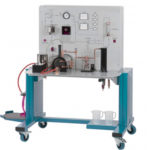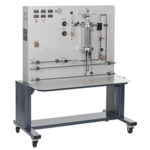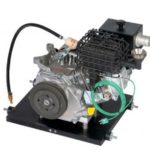Model No- AE0236
In a steam engine, thermodynamic energy in the form of vapour pressure from steam generators is converted into mechanical energy. This can be used further downstream in the process to generate electricity or to power machinery and vehicles. A steam power plant consists of a heat source for generating steam, a turbine or steam engine with a generator, and a cooling device for condensing the exhaust steam.
The trainer contains the main components of a steam power plant: a gas-fired steam boiler, a single-cylinder piston steam engine with a generator, a condenser, a feed water tank, and a feed water pump. The steam boiler generates water steam and supplies it to the piston steam engine. A piston and a crank mechanism convert the energy from the steam into mechanical energy.
Learning Objectives/Experiments
Demonstration of the function of a steam engine
Familiarisation with the components of a steam power plant and how they interact
Recording the vapour pressure curve
Effect of re-evaporation and backfeed of cold water
Determining fuel consumption, the amount of steam generated, the boiler efficiency, and the capacity of the condenser
Features
Functional model of a steam power plant
Demonstrates the function of a steam engine
Specification
Demonstration of a steam power plant with single-cylinder piston steam engine
Gas-fired boiler for steam generation
Water-cooled condenser
DC generator
Light bulbs as consumers
Sensor and display for temperature, pressure, flow rate, voltage and current
Safety valve and temperature monitoring for safe operation
Technical Data
Steam engine
power: max. 5W
speed: max. 1200min-1
cylinder: Ø 20mm
Generator
DC motor: max. 3,18W at 6000min-1
Gas-fired boiler
safety valve: 4bar
gas connection 3/8“L (propane or butane)
Measuring ranges
temperature: 8x -20…200°C
pressure: 0…6bar
flow rate:
0…110L/h (gas)
15…105L/h (water)
voltage: 0…10VDC
current: 0…250mA
230V, 50Hz, 1 phase
230V, 60Hz, 1 phase
120V, 60Hz, 1 phase







